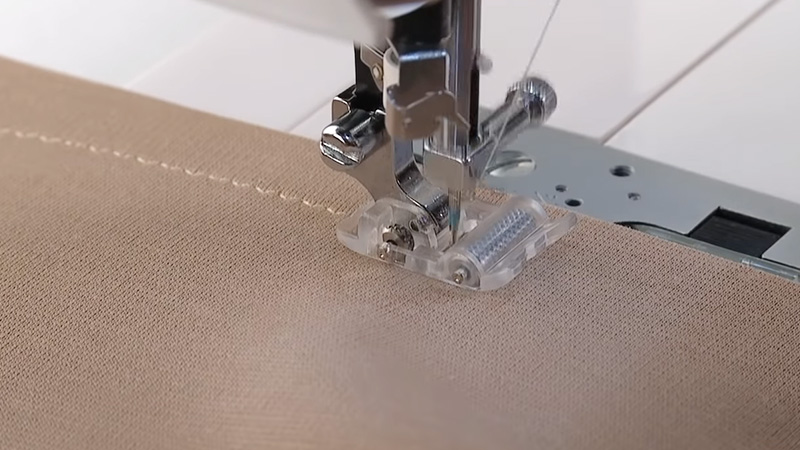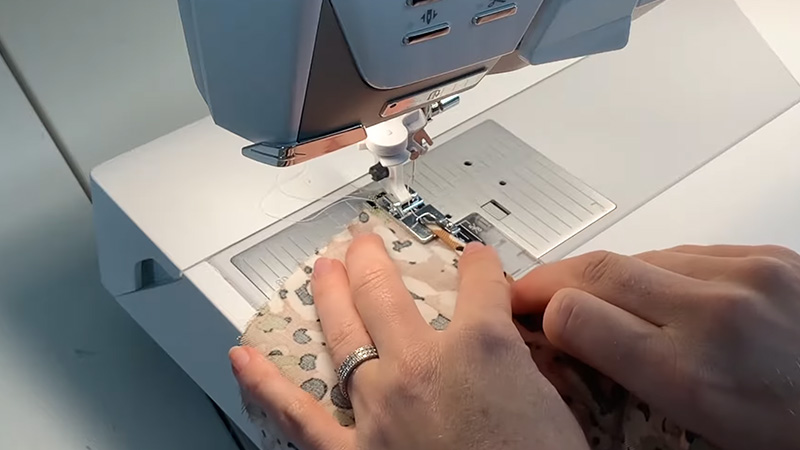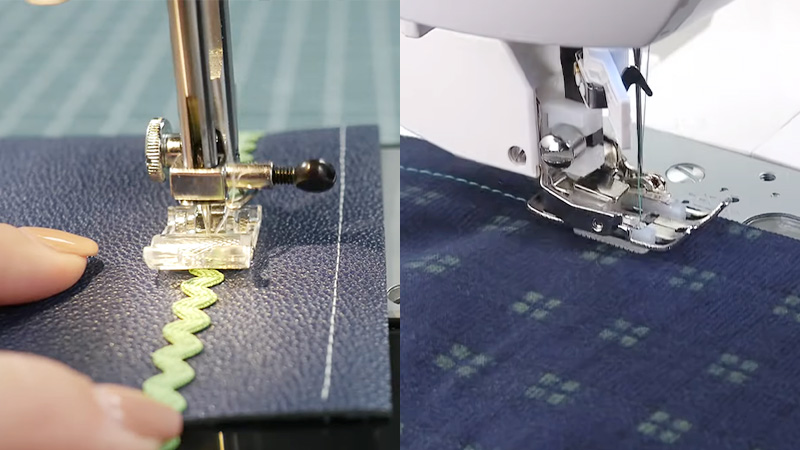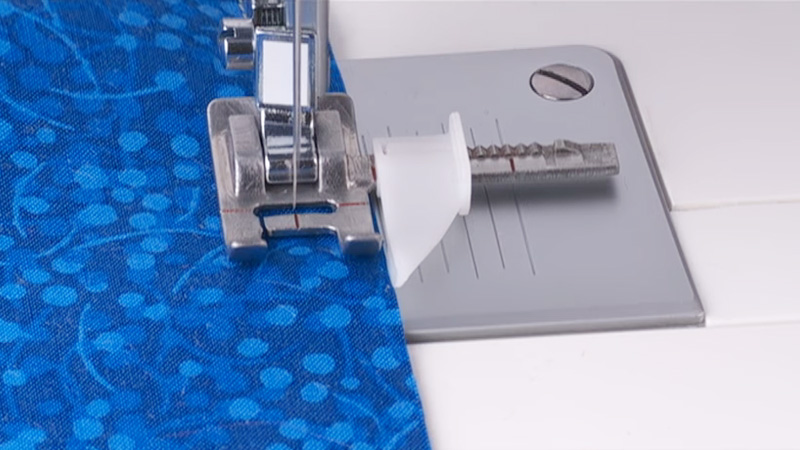The world of sewing is vast and diverse, and each project demands its unique set of tools and techniques. Among the specialized attachments that can revolutionize your sewing experience is the roller presser foot.
This unassuming presser foot, equipped with rollers, brings a level of precision and ease to your sewing endeavors that can’t be achieved with standard presser feet alone.
In this exploration of “Why You Need a Roller Presser Foot to Sew,” we will uncover seven compelling reasons behind its indispensability.
From effortlessly sewing challenging materials like leather and vinyl to achieving smooth quilting and handling adhesive fabrics, the roller presser foot is a game-changer in the sewing world.
Join us in unraveling the many facets of this essential tool and discover how it can elevate your sewing projects to new heights of quality and creativity.

Why Do You Need A Roller Presser Foot To Sew?
A roller presser foot is a specialized sewing machine foot that offers unique advantages for various sewing projects.
Here are the compelling reasons why you need a roller presser foot:
Ease of Sewing Difficult Fabrics
A roller presser foot excels at handling challenging fabrics like leather, vinyl, and laminated materials. The rollers on the foot make it easier to feed these materials through the machine, preventing slipping and puckering.
Quilting and Thick Layers
Quilters benefit from the roller foot’s ability to glide smoothly over multiple layers of fabric and batting. It helps maintain even stitching and reduces the risk of fabric shifting, ensuring precise quilting patterns.
Perfect for Sticky Fabrics
Fabrics with adhesive backing or sticky surfaces, such as vinyl or certain craft materials, can be tricky to sew. The roller presser foot’s rollers help prevent these materials from sticking to the presser foot, resulting in cleaner stitches.
Non-Marking and Non-Scratching
Roller presser feet are designed to be non-marking and non-scratching, making them suitable for delicate fabrics like silk and satin. They provide gentle yet firm pressure without leaving unwanted marks.
Easy on Knits and Stretch Fabrics
Knit and stretch fabrics often require extra care when sewing to prevent distortion. The roller foot’s smooth movement ensures that these fabrics feed evenly, resulting in professional-looking seams and hems.
Ideal for Decorative Stitching
When creating decorative stitches or adding embellishments to your projects, a roller presser foot provides consistent feeding, allowing you to maintain stitch quality and accuracy.
Smooth Curves and Corners
Sewing curved seams and corners can be challenging, but the roller presser foot’s ability to pivot smoothly helps navigate intricate curves and sharp corners with ease.
A roller presser foot is a valuable addition to your sewing toolkit, offering versatility and improved control when working with a wide range of fabrics and projects.
Whether you’re quilting, sewing delicate materials, or adding decorative touches, this foot enhances your sewing experience and ensures excellent results.
Why Do You Use A Roller Foot For Sewing?

A roller foot is a specialized sewing machine attachment that serves various purposes and proves indispensable for specific sewing tasks.
Here are the tools and applications for which you can use a roller foot:
Leather and Vinyl Sewing
When working with leather or vinyl materials, a roller foot aids in smooth fabric feeding, preventing sticking or dragging. It ensures even stitching, resulting in professional-quality seams.
Quilting and Thick Layers
Quilters find the roller foot beneficial for stitching through multiple layers of fabric and batting. It maintains an even stitch length and minimizes fabric shifting, which is crucial for precise quilting patterns.
Sticky or Adhesive Fabrics
Fabrics with adhesive backing or tacky surfaces, such as laminates and certain craft materials, tend to cling to standard presser feet. The roller foot’s rollers eliminate sticking, allowing for hassle-free sewing.
Non-Marking and Non-Scratching
Roller feet are designed to be gentle on delicate fabrics like silk and satin. They provide consistent pressure without marking or scratching the fabric, ensuring a pristine finish.
Knits and Stretch Fabrics
Roller feet excel at handling knit and stretch fabrics. They promote even feeding, preventing fabric distortion or stretching and resulting in neat, stretch-friendly seams.
Decorative Stitching
When creating decorative stitches or adding embellishments to your projects, a roller foot ensures precise feeding, helping you maintain stitch quality and accurate designs.
Navigating Curves and Corners
Sewing smoothly around curves and corners can be challenging, but the roller foot’s pivoting capability eases the process. It facilitates accurate stitching along intricate curves and sharp angles.
A roller foot is a versatile tool that enhances your sewing experience, particularly when working with challenging fabrics or specific sewing techniques. Its unique design and functionality make it an asset for a wide range of projects, from quilting to crafting and garment construction.
What Is The Difference Between Roller Foot And Walking Foot?

Roller feet and walking feet are distinct sewing machine attachments, each designed for specific sewing tasks.
Here are the key differences between them:
Function:
- Roller Foot: A roller foot is primarily used for tasks where smooth fabric feeding is crucial, such as sewing leather, vinyl, and laminated materials. It has rollers that help glide over sticky or challenging fabrics.
- Walking Foot: A walking foot, also known as an even feed foot, is designed for tasks that require both upper and lower fabric layers to move simultaneously, ensuring even feeding. It excels at sewing multiple layers and slippery fabrics.
Feed Mechanism:
- Roller Foot: The roller foot relies on rollers to move the fabric, allowing it to slide smoothly over various surfaces.
- Walking Foot: The walking foot has a set of feed dogs on the foot itself, in addition to those on the sewing machine. These feed dogs work together to evenly advance the fabric layers.
Applications:
- Roller Foot: Ideal for materials like leather, vinyl, laminates, and fabrics with adhesive backing. It helps prevent sticking and dragging.
- Walking Foot: Suited for tasks like quilting, sewing multiple layers, working with slippery or stretchy fabrics, and maintaining even stitching.
Stitch Types:
- Roller Foot: Typically used for straight stitches and basic stitching patterns, as it focuses on facilitating smooth fabric movement.
- Walking Foot: Versatile and compatible with various stitch types, including straight stitches, zigzag, and decorative stitches, while maintaining even fabric feeding.
Ease of Use:
- Roller Foot: Easy to use for specific applications where smooth fabric movement is essential. It requires less adjustment for these tasks.
- Walking Foot: This may require more setup and adjustments due to its versatile nature and compatibility with a wide range of fabrics and projects.
Versatility:
- Roller Foot: Specialized for specific sewing tasks and fabrics, making it less versatile but highly efficient for its intended purposes.
- Walking Foot: Versatile and adaptable, making it a go-to choice for many sewing projects, including quilting, garment sewing, and crafting.
Fabric Compatibility:
- Roller Foot: Suited for challenging fabrics and those with adhesive properties, ensuring smooth stitching and preventing fabric distortion.
- Walking Foot: Works well with various fabrics, including knits, quilting cotton, denim, and silk, offering consistent results across a wide fabric range.
Understanding these differences is essential for selecting the appropriate presser foot for your sewing project, ensuring that you achieve the best results and hassle-free sewing experiences.
How Much Do You Need A Presser Foot To Sew?

The pressure applied by a presser foot during sewing is a crucial factor that affects the quality and consistency of your stitches.
Here are the pressure measurements and their corresponding descriptions:
Light Pressure
Light pressure is suitable for delicate fabrics like silk, chiffon, or lightweight knits. It prevents fabric distortion, puckering, or stretching by exerting minimal pressure on the fabric.
Standard Pressure
Standard pressure is the typical setting for most sewing projects involving medium-weight fabrics like cotton or linen. It offers balanced fabric control and stitch quality.
Heavy Pressure
Heavy pressure is used when sewing thick or heavy materials such as denim, canvas, or leather. It ensures the fabric remains stable and feeds smoothly under the presser foot.
Adjustable Pressure
Some sewing machines offer adjustable pressure settings. This allows you to fine-tune the pressure to suit the specific fabric you’re working with, ensuring optimal stitch results.
Differential Pressure
In some cases, you may need differential pressure adjustments when working with fabrics that have varying thicknesses, like quilting layers. This feature helps maintain consistent fabric feeding.
Walking Foot Pressure
When using a walking foot or even a feed foot, you may need to adjust the pressure on the foot itself to match the fabric thickness. This ensures that both fabric layers are fed evenly.
High Pressure for Embroidery
For machine embroidery, you may need higher pressure settings to keep the fabric stable and prevent puckering while the needle creates intricate designs. Adjust the pressure as needed for embroidery projects.
The right pressure setting ensures that the fabric feeds smoothly and evenly, preventing issues like skipped stitches, fabric bunching, or distortion. Refer to your sewing machine’s manual to understand how to adjust the presser foot pressure, as it may vary depending on your machine’s make and model.
FAQs
Why should I consider using a roller presser foot in my sewing projects?
A roller presser foot is a game-changer in sewing because it offers effortless control over challenging fabrics like leather, vinyl, and laminated materials. It ensures smooth fabric feeding, prevents sticking, and maintains even stitches, making it indispensable for various sewing tasks.
Can I use a roller presser foot for quilting projects?
Absolutely! A roller presser foot is perfect for quilting. It glides seamlessly over multiple layers of fabric and batting, ensuring precise quilting patterns and minimizing fabric shifting during the process.
How does a roller presser foot handle sticky or adhesive fabrics?
The rollers on the foot prevent sticky or adhesive fabrics from clinging to the presser foot. This feature makes it easier to sew materials with adhesive backing, laminates, or craft materials without hindrance.
Is a roller presser foot suitable for delicate fabrics like silk or satin?
Yes, a roller presser foot is gentle on delicate fabrics. It exerts consistent yet non-marking pressure, making it ideal for sewing delicate materials without leaving unwanted imprints.
What types of sewing projects can benefit from a roller presser foot?
A roller presser foot enhances a wide range of sewing projects, including leatherworking, quilting, sewing with adhesive fabrics, crafting with sticky materials, and even handling challenging fabrics like vinyl and denim.
It offers versatility and precision, making it an invaluable tool for various sewing tasks.
Conclusion
In the realm of sewing, the choice of presser foot can significantly impact the outcome of your projects. As we conclude our journey into “Why You Need a Roller Presser Foot to Sew,” it’s clear that this unassuming attachment offers a multitude of advantages.
From simplifying the sewing of sticky fabrics and ensuring smooth stitching on quilts to providing a gentle touch on delicate materials, the roller presser foot proves its worth time and again.
Whether you’re a seasoned sewing enthusiast or just starting your crafting journey, adding a roller presser foot to your toolkit can open up a world of possibilities. Its versatility and ability to conquer various sewing challenges make it an essential companion for creating beautiful, professional-quality garments, accessories, and quilts.
Embrace the roller presser foot and watch your sewing projects flourish with precision and ease.
Leave a Reply